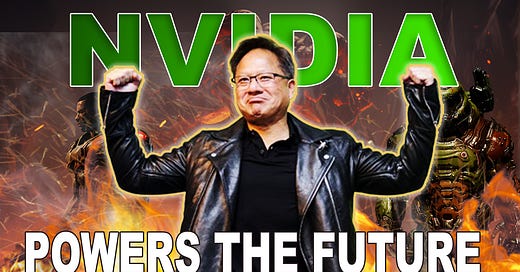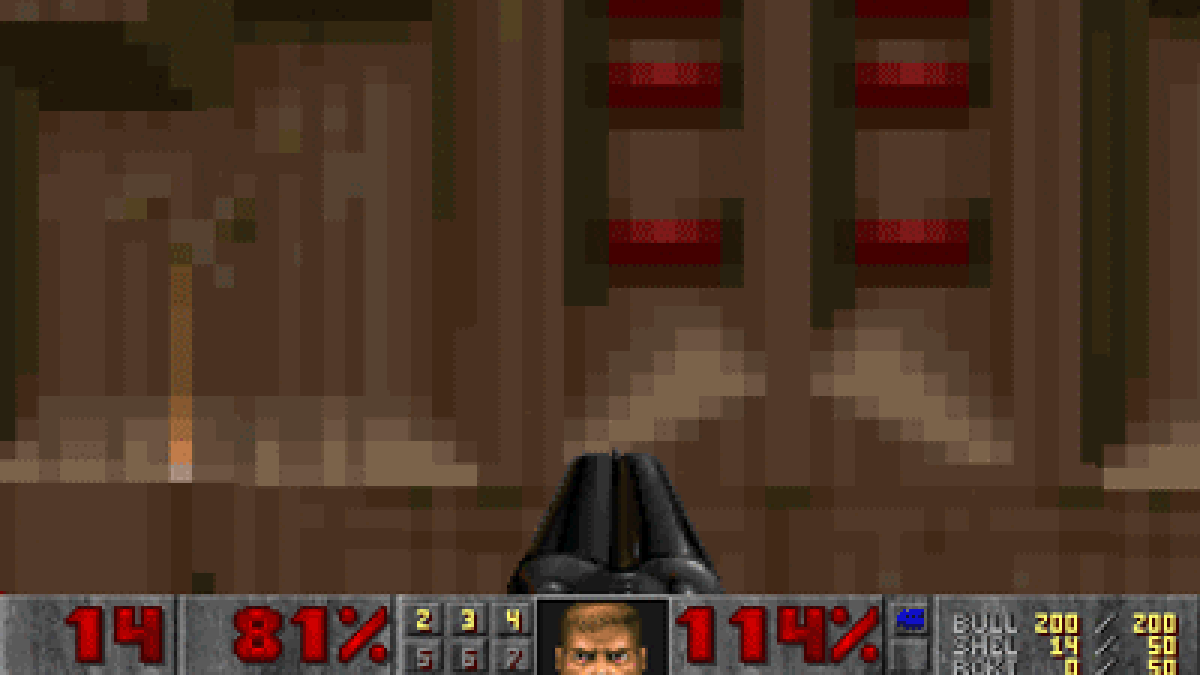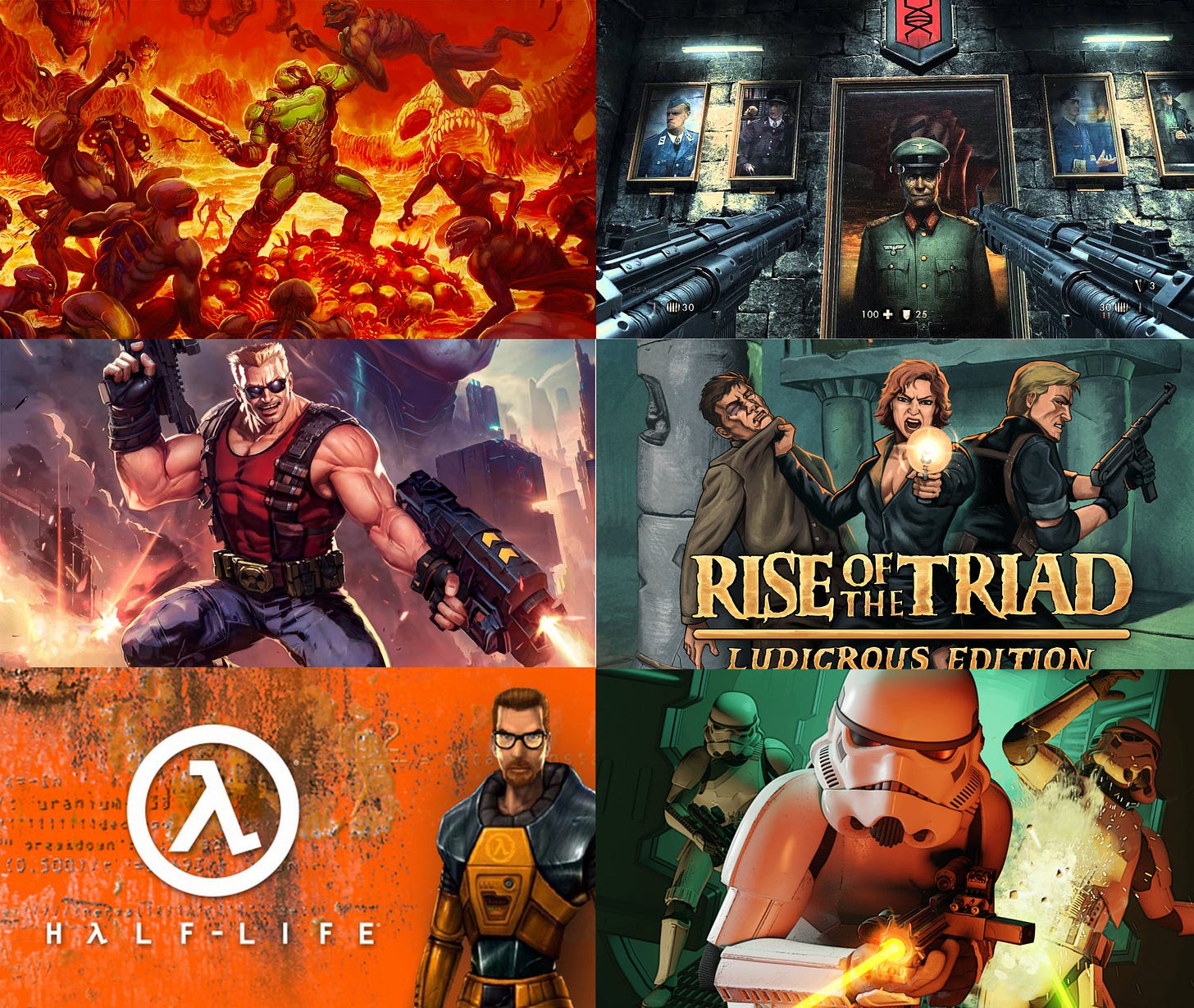“Every market we go to, we have a domain-specific language. Every domain-specific language, underneath, has an architecture.” - Jensen Huang
Watch the newsletter
In the 90s, I barely knew anyone with a computer. Except my grandmother, who had a Gateway PC with Windows 95 installed. My grandmother barely knew how to use the thing, but it was a flex to have a computer back then. One day, in maybe ‘97, I was at her house and there was a floppy disk on the computer hard drive. I checked the system folder and the floppy disk read “DOOM”. It could have been a virus, but it looked like a game. I launched the application and instantly became a participant in one of computer history’s greatest moments. The difficulty options were intimidating, “I’m too young to die”, “Hurt me plenty”, “Ultra Violence”, and “Nightmare”. A few hours later, I was dazed and confused. Whatever I just played…was awesome! The soundtrack and the fast-paced, smooth gameplay were mind-blowing. Little did I know that DOOM was also inspiring the idea for one of today’s greatest tech companies. Remember to like, comment, and subscribe to help Medallion XLN create the new internet.
DOOM ‘93 is one of gaming’s most important releases
The mid-90s slew of amazing first-person shooters (FPS) created a tech boom. Id software cranked out classics such as Wolfenstein 3D, DOOM, and Quake. Many offshoots, known as Doom-clones (or Boomer shooters), created classics such as Duke Nukem 3D, Star Wars: Dark Forces, Rise of Triad and so much more. I was in elementary school at the time, engaging with the discourse, “Duke Nukem has boobs”. Many keen-eyed entrepreneurs realized a problem needed to be addressed that would usher in the next generation of computing. The excitement around these games sparked a parallel tech boom in the semiconductor industry. Over 70 startups were competing for the number one spot. As the dust settled, only a scrappy startup named NVIDIA, led by Jensen Huang, emerged to declare victory over their competitors. To understand the significance of NVIDIA’s contribution to the semiconductor space, our focus begins with understanding the Central Processing Unit (CPU). The CPU is the brain of every computer that runs the machine’s operating system and applications. Each core of the CPU handles one task at a time. The FPS games require a lot of computation to calculate the appearance of all the lights and shadows. An intense game like DOOM could bring a CPU to a halt if not for John Carmack’s Binary Space Partitioning algorithm which was used when it was discovered that stairs were slowing the game down. NVIDIA’s NV1 Multimedia Card graphics processing unit (GPU) included 2D graphics processing, a 3D graphics accelerator, a sound card, and a port for game controllers. NVIDIA developed partnerships with gaming giants such as SEGA and the processors were integrated into Video Game arcades that powered 3D games such as Sonic Racing and Virtua Fighter. SEGA partnered with NVIDIA to fund the NV2 which used ideas inherited from the SEGA Saturn to develop what would have become the SEGA Dreamcast. Unfortunately, SEGA decided to go with a different vendor because the NV2 used quadrilaterals that were incompatible with Microsoft’s DirectX industry-standard polygon rendering. This event hit NVIDIA hard.
Boomer shooters helped to usher in the age of hardware acceleration
NVIDIA came roaring back with the NV3 RIVA 128 with Direct3D support, high performance, and lower cost than the main competitor. After receiving PC magazine’s editors choice award, NVIDIA went on to conquer 24% of the semiconductor market. When the stock went public in 1998, NVIDIA was worth $600 million. The meteoric rise of NVIDIA made them a target for lawsuits over patent infringements from 3dfx, which after winning, bankrupted 3dfx, allowing NVIDIA to buy them up and own all of their patents. New partnerships for Microsoft’s Xbox, Sony’s PlayStation, and Apple computers solidified NVIDIA’s position as the defacto industry leader in hardware acceleration throughout the early 2000s. NVIDIA gained more market share after its main competitor ATI sold to AMD for $5.4B. NVIDIA introduced a Unified Integrated Shader Architecture for PC, cuda parallel computing, the PhysX physics engine, and Ray Tracing with the GeForce RTX. Around this time, Data Science began to take off and NVIDIA’s products were the chosen GPUs to perform complex matrix multiplication for machine learning and deep learning. NVIDIA is also the chosen GPU for cryptocurrency mining, which caused a supply bottleneck, resulting in the increase of price per GPU. Car manufacturers have also chosen NVIDIA processors to integrate into their vehicles. As of today, NVIDIA dominates with 84% market share.
Jensen Huang, CEO of NVIDIA leads hardware acceleration
During the great gold rush of the 1800s, the one who sold the shovels earned the most money. In a way, it doesn’t matter to NVIDIA who wins the AI wars nor which cryptocurrency comes out on top because they provide the necessary GPUs. NVIDIA is best situated to benefit from all current technology trends, from EV, AI, Crypto, Data centers, and the Metaverse. 2 weeks ago, at SIGGRAPH 2023, Jensen Huang gave us a peak into the future of computer graphics. He demonstrated “Racer RTX”, with 250 million polygons, 10 rays per pixel, and 10 bounces per ray, and uses DLSS (Deep Learning Super Sampling) to render a real-time video animation in 4k at 30 hertz. Huang has also claimed to completely re-invent the GPU for artificial intelligence with a product that has 1 trillion transistors, weighs 70 pounds, and looks like the engine of a sports car. He boasts the significance of Generative AI and declares that being human is the new programming language, then introduces the Grace Hopper superchip, which is a processor specifically dedicated to Large Language Models with 4 pedaflops of transformer processing capabilities at 5 terabytes per second. I don't know what any of that means, but "Can it fit in a laptop?" If it can, then, "Take my Money!" If NVIDIA’s past is any indicator of their future success, then this underdog has been the top dog the whole time. We’re only just beginning to notice it.
NVIDIA’s announcement at SIGGRAPH 2023 deserves the hype
Join Medallion XLN and be a part of our mission to develop the next era of technology through XR, Blockchain, and AI, and harness the power of decentralization, empowering us to reclaim control over our digital independence.







